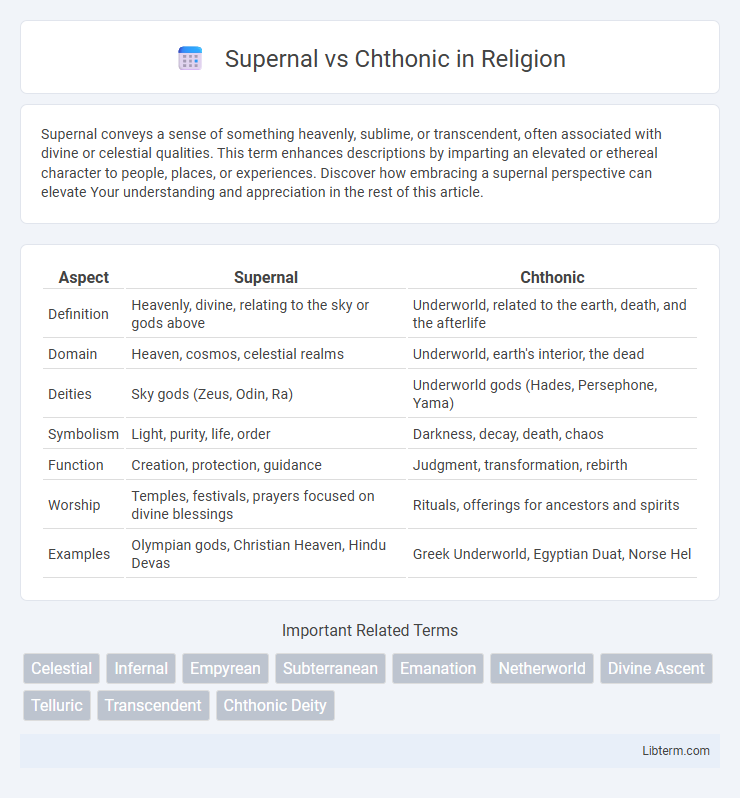Supernal conveys a sense of something heavenly, sublime, or transcendent, often associated with divine or celestial qualities. This term enhances descriptions by imparting an elevated or ethereal character to people, places, or experiences. Discover how embracing a supernal perspective can elevate Your understanding and appreciation in the rest of this article.
Table of Comparison
| Aspect | Supernal | Chthonic |
|---|---|---|
| Definition | Heavenly, divine, relating to the sky or gods above | Underworld, related to the earth, death, and the afterlife |
| Domain | Heaven, cosmos, celestial realms | Underworld, earth's interior, the dead |
| Deities | Sky gods (Zeus, Odin, Ra) | Underworld gods (Hades, Persephone, Yama) |
| Symbolism | Light, purity, life, order | Darkness, decay, death, chaos |
| Function | Creation, protection, guidance | Judgment, transformation, rebirth |
| Worship | Temples, festivals, prayers focused on divine blessings | Rituals, offerings for ancestors and spirits |
| Examples | Olympian gods, Christian Heaven, Hindu Devas | Greek Underworld, Egyptian Duat, Norse Hel |
Understanding the Terms: Supernal and Chthonic
Supernal refers to things related to the heavens, sky, or divine realms, often symbolizing light, purity, and celestial power in mythology and spirituality. Chthonic pertains to the underworld, earth, or subterranean forces, associated with darkness, mystery, and primordial influences in ancient beliefs. Understanding the terms supernal and chthonic involves recognizing their contrasting domains--celestial versus terrestrial--and the symbolic meanings assigned to these realms across cultures.
Historical Contexts of Supernal and Chthonic
Supernal and chthonic concepts originate from ancient mythologies, where supernal refers to deities or forces associated with the sky, heavens, and celestial realms, symbolizing divine authority and cosmic order. Chthonic pertains to gods and spirits of the underworld and earth, representing death, fertility, and the cycle of life beneath the surface world. Historical contexts reveal these dualities in cultures such as ancient Greece, where Olympian gods dominated the heavens while chthonic deities like Hades ruled the underworld, reflecting humanity's understanding of life, death, and the cosmos.
Supernal: The Realm of the Divine
Supernal, often described as the Realm of the Divine, encompasses celestial beings, gods, and transcendent light, representing purity, enlightenment, and higher consciousness. This realm symbolizes ultimate spiritual authority and eternal bliss, contrasted sharply with the dark, subterranean qualities of the Chthonic, which pertains to the underworld and earth-bound spirits. In mythologies and esoteric traditions, Supernal embodies divine intervention, cosmic order, and sacred knowledge beyond the mortal plane.
Chthonic: The Power of the Underworld
Chthonic refers to the deep, primal forces of the underworld, embodying the mysterious and often dark powers beneath the earth's surface. This concept is central to many mythologies, symbolizing death, rebirth, and hidden knowledge accessible only through descent into the subconscious or the afterlife. In contrast to the supernal, which represents celestial and divine realms, chthonic forces govern the unseen, fertile, and transformative aspects of existence linked to the underworld's potent spiritual energy.
Comparative Mythology: Supernal vs Chthonic
Supernal beings are associated with the heavens, light, and order, often embodying divine authority and transcendence, while chthonic entities relate to the underworld, darkness, and earth, symbolizing death, fertility, and the subconscious. Comparative mythology reveals that many cultures conceptualize this duality to explain cosmic balance, moral polarity, and human life cycles through contrasting deities and spirits. The interplay between supernal and chthonic forces underscores recurring themes of creation, destruction, and regeneration across global mythological traditions.
Symbolism and Iconography in Supernal and Chthonic Beliefs
Supernal symbolism often features light, celestial bodies, and upward motifs representing divinity, purity, and transcendence, while chthonic iconography employs darkness, earth elements, and underworld creatures symbolizing death, rebirth, and hidden knowledge. In supernal beliefs, icons such as radiant halos, wings, and ethereal landscapes emphasize connection to the heavens and spiritual elevation. Chthonic imagery typically includes serpents, skulls, and subterranean symbols that evoke the mysteries of the afterlife and the cyclical nature of existence.
Philosophical Interpretations: Above and Below
Supernal and chthonic symbolize the philosophical dichotomy between transcendence and immanence, representing realms above and below that shape human understanding of existence. Supernal embodies divine order, light, and spiritual ascent, while chthonic reflects chaos, darkness, and the subconscious depths of the psyche. These interpretations highlight the tension between lofty ideals and primal forces within philosophical and mythological frameworks.
Cultural Significance of Supernal and Chthonic Forces
Supernal forces symbolize transcendence, divine authority, and enlightenment in various cultures, often associated with gods, celestial beings, and the heavens. Chthonic forces represent the underworld, death, rebirth, and the primal aspects of nature, deeply rooted in mythologies surrounding the earth and the afterlife. These opposing forces illustrate humanity's attempt to understand the balance between life and death, light and darkness, order and chaos in cultural narratives.
Supernal and Chthonic in Modern Spirituality
Supernal represents the transcendent, divine realms associated with light, purity, and celestial beings, reflecting aspirations toward enlightenment and higher consciousness in modern spirituality. Chthonic refers to the underworld and earthbound forces, symbolizing primal energies, transformation, and the subconscious mind's depths. Contemporary spiritual practices often integrate Supernal and Chthonic elements to balance transcendence with grounding, fostering holistic personal growth and shadow work.
Balancing Supernal and Chthonic Energies
Balancing Supernal and Chthonic energies involves harmonizing the celestial forces of enlightenment and higher consciousness with the primal, earthbound powers of instinct and transformation. Effective integration of Supernal energies fosters spiritual ascension and clarity, while channeling Chthonic energies supports grounding, resilience, and deep emotional healing. This equilibrium enhances personal growth by uniting transcendence with innate strength, creating a holistic path to empowerment and self-awareness.
Supernal Infographic

 libterm.com
libterm.com